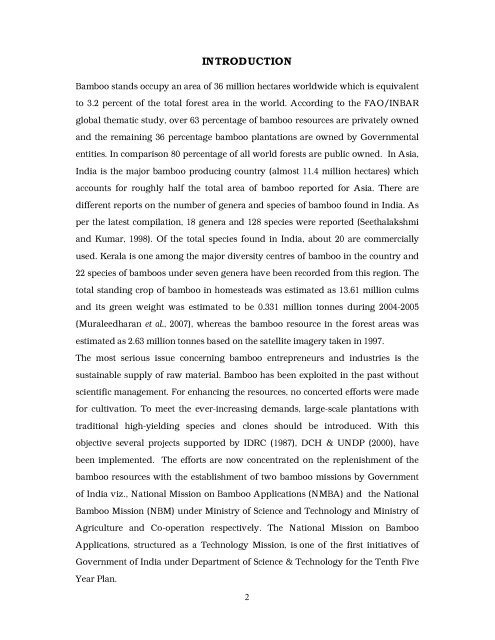Multilocational field trials for selected bamboo species
Multilocational field trials for selected bamboo species
Multilocational field trials for selected bamboo species
You also want an ePaper? Increase the reach of your titles
YUMPU automatically turns print PDFs into web optimized ePapers that Google loves.
INTRODUCTION<br />
Bamboo stands occupy an area of 36 million hectares worldwide which is equivalent<br />
to 3.2 percent of the total <strong>for</strong>est area in the world. According to the FAO/INBAR<br />
global thematic study, over 63 percentage of <strong>bamboo</strong> resources are privately owned<br />
and the remaining 36 percentage <strong>bamboo</strong> plantations are owned by Governmental<br />
entities. In comparison 80 percentage of all world <strong>for</strong>ests are public owned. In Asia,<br />
India is the major <strong>bamboo</strong> producing country (almost 11.4 million hectares) which<br />
accounts <strong>for</strong> roughly half the total area of <strong>bamboo</strong> reported <strong>for</strong> Asia. There are<br />
different reports on the number of genera and <strong>species</strong> of <strong>bamboo</strong> found in India. As<br />
per the latest compilation, 18 genera and 128 <strong>species</strong> were reported (Seethalakshmi<br />
and Kumar, 1998). Of the total <strong>species</strong> found in India, about 20 are commercially<br />
used. Kerala is one among the major diversity centres of <strong>bamboo</strong> in the country and<br />
22 <strong>species</strong> of <strong>bamboo</strong>s under seven genera have been recorded from this region. The<br />
total standing crop of <strong>bamboo</strong> in homesteads was estimated as 13.61 million culms<br />
and its green weight was estimated to be 0.331 million tonnes during 2004-2005<br />
(Muraleedharan et al., 2007), whereas the <strong>bamboo</strong> resource in the <strong>for</strong>est areas was<br />
estimated as 2.63 million tonnes based on the satellite imagery taken in 1997.<br />
The most serious issue concerning <strong>bamboo</strong> entrepreneurs and industries is the<br />
sustainable supply of raw material. Bamboo has been exploited in the past without<br />
scientific management. For enhancing the resources, no concerted ef<strong>for</strong>ts were made<br />
<strong>for</strong> cultivation. To meet the ever-increasing demands, large-scale plantations with<br />
traditional high-yielding <strong>species</strong> and clones should be introduced. With this<br />
objective several projects supported by IDRC (1987), DCH & UNDP (2000), have<br />
been implemented. The ef<strong>for</strong>ts are now concentrated on the replenishment of the<br />
<strong>bamboo</strong> resources with the establishment of two <strong>bamboo</strong> missions by Government<br />
of India viz., National Mission on Bamboo Applications (NMBA) and the National<br />
Bamboo Mission (NBM) under Ministry of Science and Technology and Ministry of<br />
Agriculture and Co-operation respectively. The National Mission on Bamboo<br />
Applications, structured as a Technology Mission, is one of the first initiatives of<br />
Government of India under Department of Science & Technology <strong>for</strong> the Tenth Five<br />
Year Plan.<br />
2

















